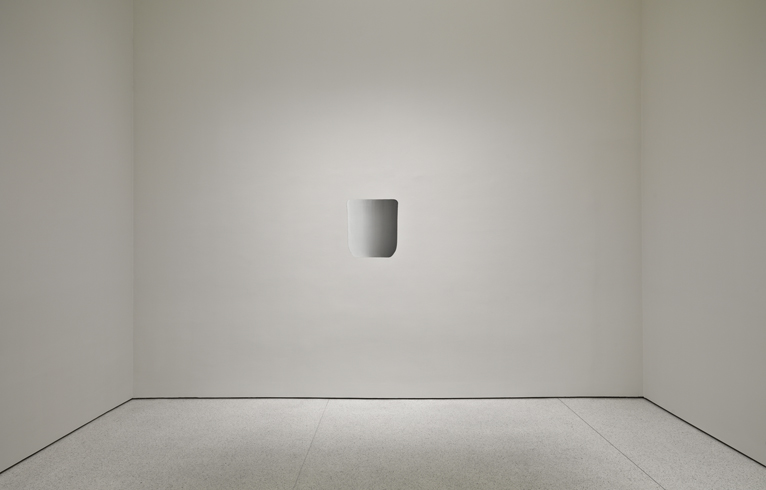LEE UFAN: MARKING INFINITY
| December 14, 2011 | Post In LEAP 11

The canonizing ramps of the Guggenheim rotunda played host to this five-decade retrospective of Korean-Japanese artist Lee Ufan (b. 1936), tracing his prolific career in a chronological and thematic upward spiral curated by Alexandra Munroe. Series of gestural, postminimalist paintings punctuated the hike, while sculptures informed by inherent and enlivened “encounters” among things of different materiality blocked the path, causing minor detours that subsequently forced a slight alteration in the viewer’s perspective. And perhaps appropriately: in the dynamic flux of Lee’s philosophy, where works of art function in “resonant relationships with the outside,” the artist does not create so much as mediate a process.
Lee Ufan was the best-known practitioner and prime theoretician of the loosely organized and short-lived (1968-1972) “Mono-ha” (often translated as “School of Things”), a collective for whom the aesthetic notion of “encounter” as a phenomenological event figures prominently. For this exhibition, the now 75-year-old Lee reenacted his Mono-ha period staple Phenomenon (1968), lifting a brawny boulder to crack a thin glass sheet lying atop a commensurately sized steel plate. In this “controlled accident” mediated by Lee, fundamentally different materials— industrial versus natural, taken as they are yet not readymades— exist in a peculiar, dynamic relationship of “things” that extend to include their environs and the audience. Heavily influenced by the phenomenologist Maurice Merleau-Ponty, one of Lee’s heroes while studying at Nihon University, Lee’s sculptural oeuvre— retroactively titled Relatum— also vividly evokes elements of Zen, from the spiritual notion of sudden enlightenment, to the topological articulation of Zen garden arrangements. Throughout the ramps and ancillary galleries, assortments of stones rigorously hand-picked by the artist at a Long Island quarry do things. Some meditate by opposing a slanting steel plate; others distort a scaled stripe and by extension its encoded system of measurement, or rest en masse atop soft cushions. Works involving steel plates, flat or elegantly bent, inevitably recall Richard Sera, minus the overwhelming physicality.
The untrammeled qualities of Lee Ufan’s art belie the tumultuous conditions of their making. Mono-ha, for instance, emerged less as a critique of Modernism than a reaction to generations of Japanese artists precipitately in thrall to Western models up to and including the Euro-American avant-garde. It then succeeded as a style and mode of art-making firmly rooted in East Asian philosophy and aesthetics yet internationally relevant. Perhaps this fraught geopolitical standing is appropriate given Lee’s perpetual “otherness” as an individual born in wartime Korea but splitting his life between Tokyo and Paris.
If intricately staged encounters between colliding material realities may not be sensational enough for today’s audiences— accustomed to spectacles like exploding cars hanging from the Guggenheim ceiling— Lee Ufan’s paintings do not fail to grip. In the two series from the 1970s— “From Point” and “From Line,” essentially his childhood training in classic brush techniques writ large— the artist deployed iterative marking of points and lines in graphing time and space. Looking at From Point (1975), one could almost conjure up the artist at work, making consecutive strokes in neat orders rightward with a brush loaded with orange ochre paint symbolic of the earth; when the pigment was exhausted, he would dip the brush and repeat the process. The notion of yohaku, interpreted by Lee as the “the echo that carries into silence,” suggests the limitless dimensions these canvases generate beyond frame. Appreciating from afar, From Point (1975) also works in uncanny resonance with the architectonics of the exhibition space: the points form pulsating lines dashing leftward, the rare example of a work augmented and not overshadowed by Wright’s monumental curves.
In the 1980s, Lee Ufan gradually allowed his brushwork to loosen up a little, populating the canvas with squiggly, calligraphic lines (as in the “With Winds” series) that nevertheless shy away from the splashy, charged fields of an Abstract Expressionist. Only in the innermost gallery at the zenith does the quivering sensation of the extreme minimal suspended at the threshold of spatiotemporal infinitude come alive. In the exhibition’s lone site-specific work Dialogue-Space (2009-2011), Lee paints one large, bold grisaille brushstroke directly on the pristine white surface of each of three adjacent walls. Tactile yet eerily supernatural, the three marks appear almost afloat in mid-air, resembling empty stainless-steel utensils. As throughout this self-effacing exhibition, you’d have to empty yourself first in order to resonate. Xin Wang

